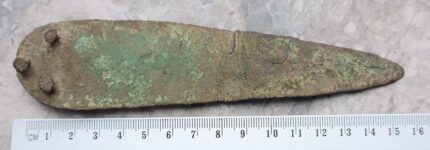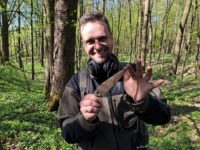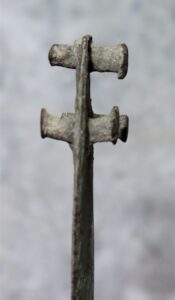 A rare Bronze Age dagger has been discovered in a forest near Krasnystaw in southeastern Poland. It is in good condition, with no evidence of wear on the edges. It was cast in a lenticular shape with a rib down the center. The semi-circular base has three rivets on each side to which a handle would have been fastened. The handle, likely made out of wood, is now lost.
A rare Bronze Age dagger has been discovered in a forest near Krasnystaw in southeastern Poland. It is in good condition, with no evidence of wear on the edges. It was cast in a lenticular shape with a rib down the center. The semi-circular base has three rivets on each side to which a handle would have been fastened. The handle, likely made out of wood, is now lost.
The dagger is believed to date to around 1500 B.C. and is the first of its kind found in the area. In fact, it is one of only a dozen or so known to have been found in all of Poland. It was not of local manufacture, but rather arrived in the region with people who inhabited the Danube area in what are now Hungary, the Czech Republic, Austria and Slovakia.
 It was found by a metal detectorist working with the Wolica historical association under the aegis of the Lublin Provincial Conservator of Monuments. They were looking for objects from the World Wars when they came across the dagger in shallow soil just a few centimeters under the surface. They took pictures and recorded the precise the location to report the find, but encountered no other archaeological material at the site.
It was found by a metal detectorist working with the Wolica historical association under the aegis of the Lublin Provincial Conservator of Monuments. They were looking for objects from the World Wars when they came across the dagger in shallow soil just a few centimeters under the surface. They took pictures and recorded the precise the location to report the find, but encountered no other archaeological material at the site.
 A comparable riveted dagger was discovered near Olsztyn in northern Poland in 2014. It was found in a grave just below the arable surface which, while damaged, was found to contain other valuable goods including a gold hair jewel, bronze wire beads and glass beads. The gold and glass were expensive imported items, and the weapon indicates this was the burial of a high-status male.
A comparable riveted dagger was discovered near Olsztyn in northern Poland in 2014. It was found in a grave just below the arable surface which, while damaged, was found to contain other valuable goods including a gold hair jewel, bronze wire beads and glass beads. The gold and glass were expensive imported items, and the weapon indicates this was the burial of a high-status male.
The grave was classified as one of the Smoszew type, a cemetery characterized by barrows of the Bronze Age Tumulus Culture, ca. 1600-1300 B.C. Unfortunately the recently-discovered dagger was not found in its original context, so we don’t know if it was part of the furnishings of a grave.
The dagger is now being analyzed and studied by the Lublin Provincial Conservator of Monuments. Archaeologists are exploring the find site for further information about the piece, its age and how it got there.